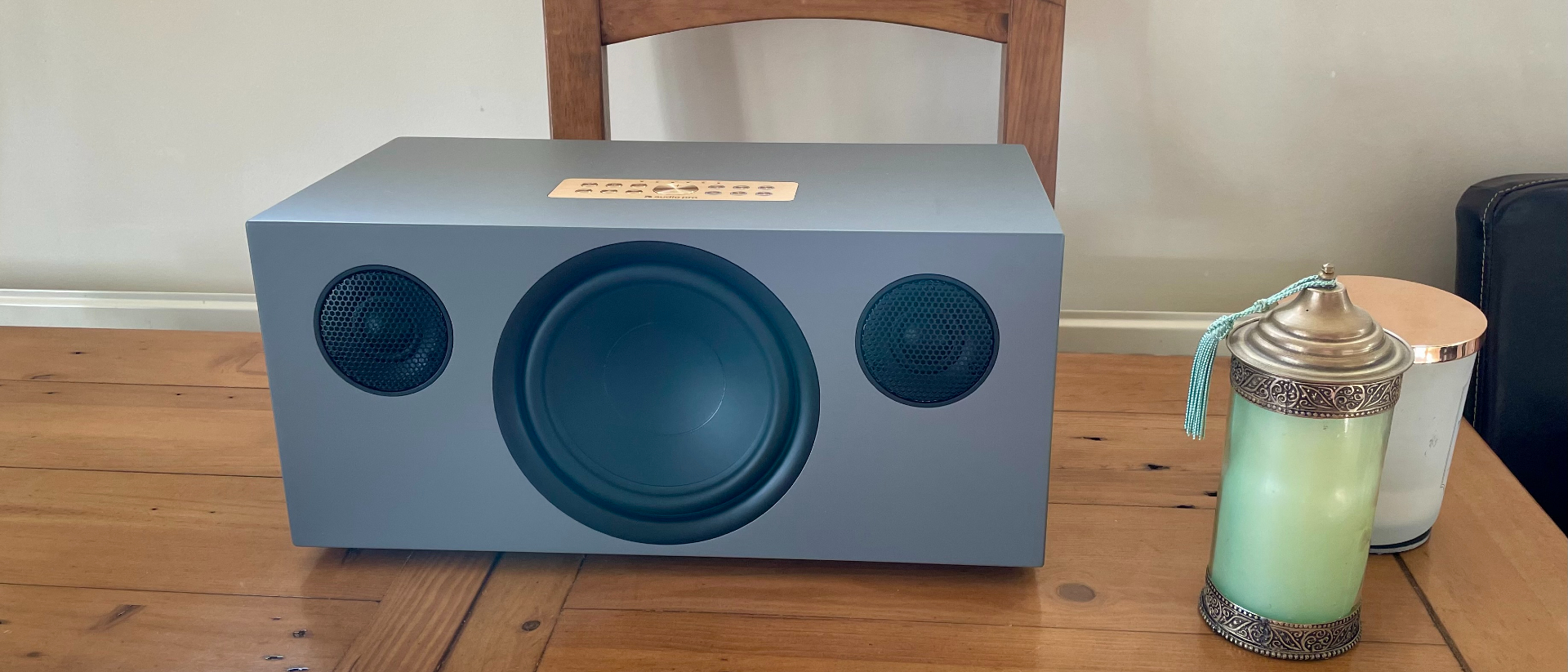TechRadar Verdict
When it comes to wireless connectivity, Audio Pro's growing line of standalone (or multi-room friendly) speakers was no slouch before the C20. Even so, with the turntable friendly, HDMI ARC-toting, sub-out sporting, RCA hook-up-able new C20, the Swedish audio specialist has outdone itself in terms of wired options too – and the sound is simply splendid.
Pros
- +
Exuberant, insightful, detailed sound
- +
Plethora of uses – can even be a soundbar
- +
Classy build and finish
Cons
- -
Hardly a budget buy
- -
You may miss the leather handle
- -
No inbuilt voice assistant
Why you can trust TechRadar
Audio Pro C20: Two minute review
The Audio Pro C20 has a lot of connectivity options. As anyone familiar with the category of best wireless speakers knows, a box of drivers that's able to harness your home's Wi-Fi network can offer superior sound to that afforded by a Bluetooth connection, whether music is accessed via Google Cast, Apple's AirPlay, 'connected' services such as Tidal Connect (which actually lets you stream losslessly in 24-bit hi-res, where AirPlay taps out at 16-bit CD quality) or a dedicated multi-room app such as the Audio Pro Control app. And the Audio Pro C20 offers all of this.
But just quickly, let's explain why Audio Pro's latest wireless speaker is worth your time from a technical perspective. First off, pinging music over Bluetooth from phone to speaker incurs compression. Wi-Fi's higher bandwidth means you can listen in (very) high resolution, up to 24-bit/192kHz. Now, a Wi-Fi enabled speaker accesses your chosen tunes from the internet (or local drive connected to it) rather than from your phone itself – and if you walk into another room or take a call, as long as you stay within range of your Wi-Fi router, the music keeps playing.
Why explain this in the intro to a product review? Because Audio Pro gets it. The Swedish company's been in the game for 40 years and the firm gets that we want more than one open gate leading to our music. Also, we now have plenty of kit we'd like to physically connect our shiny new speaker to, if possible (and thank you very much in advance). So, on top of Wi-Fi and Bluetooth streaming, Audio Pro has added to the sizeable C20 a compelling array of ports on the back: an RCA in (for turntables with an RIAA amp), a phono MM in (for moving-magnet cartridge decks without a phono stage), an RCA sub out (if you wanted to connect a dedicated subwoofer to it), a Toslink Optical in (for CD players or budget soundbars, say) and the arguably the biggest draw of the lot – an HDMI ARC in, so it can go straight into your TV and challenge some of the best soundbars. So long as it'll fit beneath it without obscuring the screen, that is.
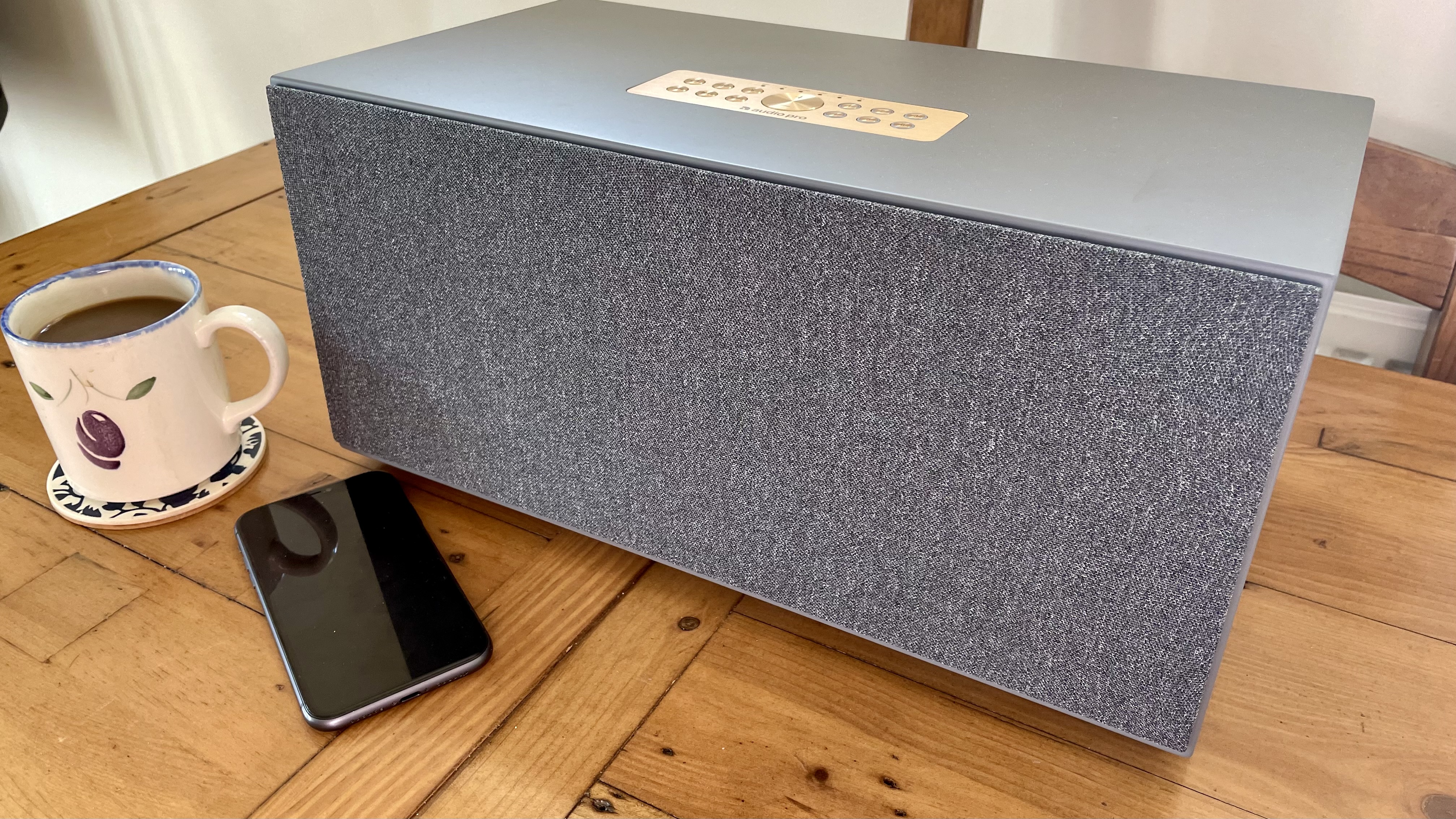
What you need to know is this: this thing sounds fantastic, offering clarity, depth, excitement and finesse, even at higher volumes. The control app is easy to navigate and corrals all of your chosen music streaming services – but of course, you could go into each app on your phone and click the little Google cast or AirPlay icon to see the C20 ready to connect.
Audio Pro calls the C20 the complete solution for music and TV and it's hard to argue. It's also hard to imagine a home interior, color scheme or decor style that the Audio Pro C20 couldn't be friends with – and the grille can remain on or easily be whipped off, if you prefer to see its three talented drivers.
The metal top plate adds an extra touch of class and the buttons click nicely, in a build that feels both reverent to traditional techniques and yet strikingly modern.
The fact that it comes from a long line of hits means it doesn't come cheap though. I've written odes to Audio Pro's beautiful speakers and I helped review the slightly smaller Audio Pro Addon C10 MkII for TechRadar's sister site, What Hi-Fi?, so I can personally vouch the five-star rating there (and the multiple awards it subsequently gained), although I fear those likely didn't do much to keep prices low.
Sign up for breaking news, reviews, opinion, top tech deals, and more.
In summary, it's chic, it's unique and it's (virtually) the complete package. Why virtually? If you wanted a 3.5mm in for your headphones (or 4.4mm, 6.35mm, or XLR), you won't find it – you'd have to go the the FiiO R9 for that. The C20 is for the enjoyment of shared music. And what an experience that is.
Audio Pro C20 review: Price and release date
- Unveiled January 8, 2024, shipping from March 2024
- $550 / £450 / €550 (around AU$820)
The Audio Pro C20 is available for pre-order now, and ships from March 2024. In the US, it costs $550 and in the UK, it'll set you back £450, hardly a trifling sum, whatever whistles and bells it sports.
That said, the competition here isn't much more affordable. Yes, the Q Acoustics M40 HD is (excellent and) a music system squirrelled into a set of speakers, but as far as wireless connectivity goes, it's a Bluetooth only one. Then, there's the fantastic FiiO R9, with all of the connectivity and hi-res wireless streaming smarts you could wish for, as long as you'll provide your own speakers or headphones.
Sonus Faber and Naim also offer similar solutions – see the Naim Mu-so Qb, a 2019 release which doesn't boast an HDMI ARC input, support, or the Sonus Faber Omnia, which does – but while the former is now available for similar money to the C20, the latter is a lot more expensive…
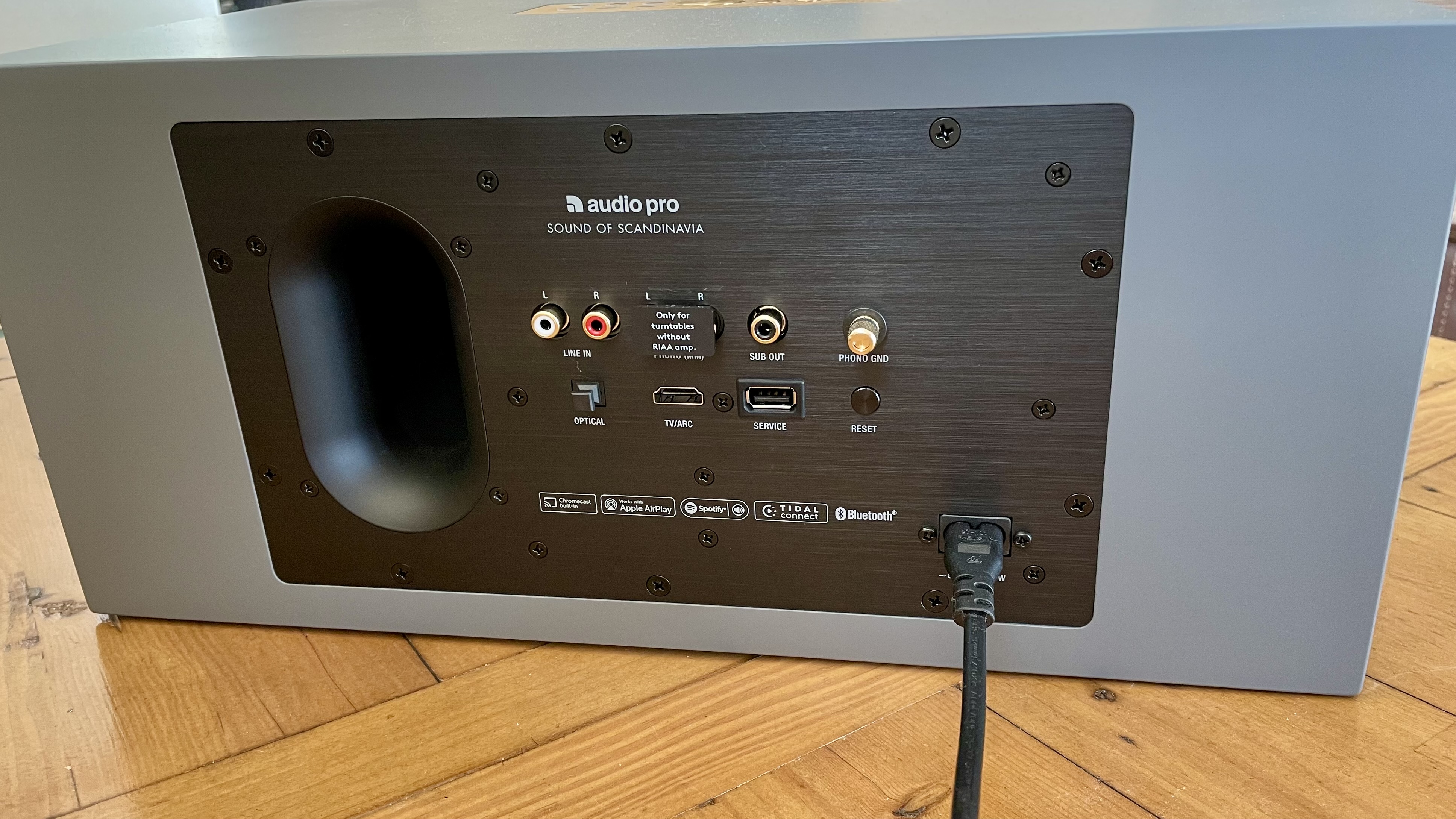
Audio Pro C20 review: Specs
| Drivers | 2x 1-inch tweeters, 1x 6.5-inch woofer |
| Weight | 6.2kg |
| Connectivity (wireless) | Wi-Fi 2.4GHz/5GHz, Bluetooth 5.0, Spotify Connect, Tidal Connect, Google Cast, AirPlay 2, Audio Pro multi-room |
| Connectivity (wired) | HDMI ARC, Toslink, RCA, Phone, Line, Sub Out |
| Power | 190W (2x 30W and 1x130W Calss D amps) |
Audio Pro C20 review: Features
- Built in RIAA amplifier
- Google Cast, Apple AirPlay and Audio Pro's own multi-room audio option
- HDMI ARC
By adding a phono stage to its latest masterwork, Audio Pro C20 can be plugged straight into your devoid-of-phono turntable (as long as it sports a moving magnet cartridge), allowing you to simply power it on, select 'phono' on the Audio Pro's top plate, lower that needle and get into the groove. Got one of the best turntables with an RIAA amp inbuilt? That's OK too, there's a separate RCA line in for you too.
Of course, this is Audio Pro, so the new C20 also features the winning multi-room option triumvirate that the company introduced with the 2021-release Addon C10 MkII: AirPlay 2, Google Cast, plus its own multi-room audio capability. You also get Tidal Connect, Spotify Connect, Bluetooth (v5.0) and HDMI ARC – so you can hook it straight up to your TV.
Thanks to a combination of these these things, you can also re-stream music (including vinyl from your turntable) to other Audio Pro speakers you may have collected from its A, C, or D-series, in a wireless multi-room system around your home (and you don't even have to start making holes in your walls).
The C20 also offers the option of connecting an external subwoofer via its sub-out (the company would direct you to its own Audio Pro SW-5 or SW10) enabling you to enhance the C20's bass performance even further, should you wish – although I didn't find this necessary.
Finally, two C20’s can be set-up as a stereo pair using the Audio Pro app, or even via Apple Airplay 2. I think you'll agree, that's a lot of options. If you want a 3.5mm headphone jack, you won't find it… but do you really?
Features score: 5/5

Audio Pro C20 review: Sound quality
- Clarity, neutrality and detail in spades
- Ample bass clout without muddying the soundstage
- Not an omnidirectional solution
Simply put, the Audio Pro C20 sounds very good indeed, whether physically hooked up to your TV or turntable, or when commanded to play music by your phone. You might anticipate having to make a compromise when buying a jack-of-all-trades box – a minor hit on sound in return for something that works with everything – but not so here.
Coheed and Cambria's In Keeping Secrets of the Silent Earth: 3 accessed on Tidal Connect is a raucous proggy album and the C20 never shies away from any of it, serving indomitable energy across the frequencies in a cohesive but rigorously regimented mix.
Given delicate string progressions such as Joni Mitchell's A Case of You, Mitchell's textured vocal soars above her dynamically agile and three-dimensional Appalachian dulcimer (and James Taylor's emotive acoustic guitar) where each musical passage is given enough space to have the necessary impact the track.
When handling TV content, the C20 is an easy (easy!) step up from anything my Sony TV's speakers can do, opening out the sound and offering that extra ounce of detail through intakes of breath and clacks of high-heeled shoes on cobbles in Shetland.
It's not a Dolby Atmos solution, of course, and the sound isn't particularly omnidirectional (owing to the C20's design), but there's a wide soundstage here nonetheless.
However I listened to it across the course of my testing, the C20 continued to delight and entertain with its myriad connectivity perks, ease of use and gifted audio chops.
Sound quality score: 5/5

Audio Pro C20: Design
- 2x 30W and 1x 130W digital class D amplifiers
- Removable grille
- Choice of three finishes
The Audio Pro C20 is available in Soft Satin White, Stylish Grey or Classic Black. The woven fabric front is fixed to the C20 by magnets and can be easily removed, giving the option of two very different looks, depending on your favored aesthetic.
I like to take off the grille off to better hear (and observe) Audio Pro's iconic eyes-and-nose style driver configuration, as seen in the brand's beloved T3+, C5 MkII and C10 MkII, for starters. Here, you get two 30W and one 130W Digital Class D amplifiers, powering the C20's dual 1-inch tweeters and a 6.5-inch woofer.
At 41cm across,19.6cm high and 22cm deep (and weighing in at 6.2kg, which roughly the same as a gallon of paint), the C20 is a substantial thing and while it fits under my wall-mounted TV just fine, those thinking of using it as a soundbar will need to think about that height.
My 'Stylish Grey' sample is just that. The gold-tone top plate (with solo LEDs to denote which source you're using as well as lights around the six preset buttons) also helps and while the gold accent on the grille is gone (as seen on the C10 MkII) I don't miss it. Do I miss Audio Pro's glorious rock 'n' roll leather handle? A little, but I also concede that this isn't proposition is not meant to be especially portable.
It's always been hard to find fault with Audio Pro's build quality, and the C20 is no exception.
Design score: 4.5/5
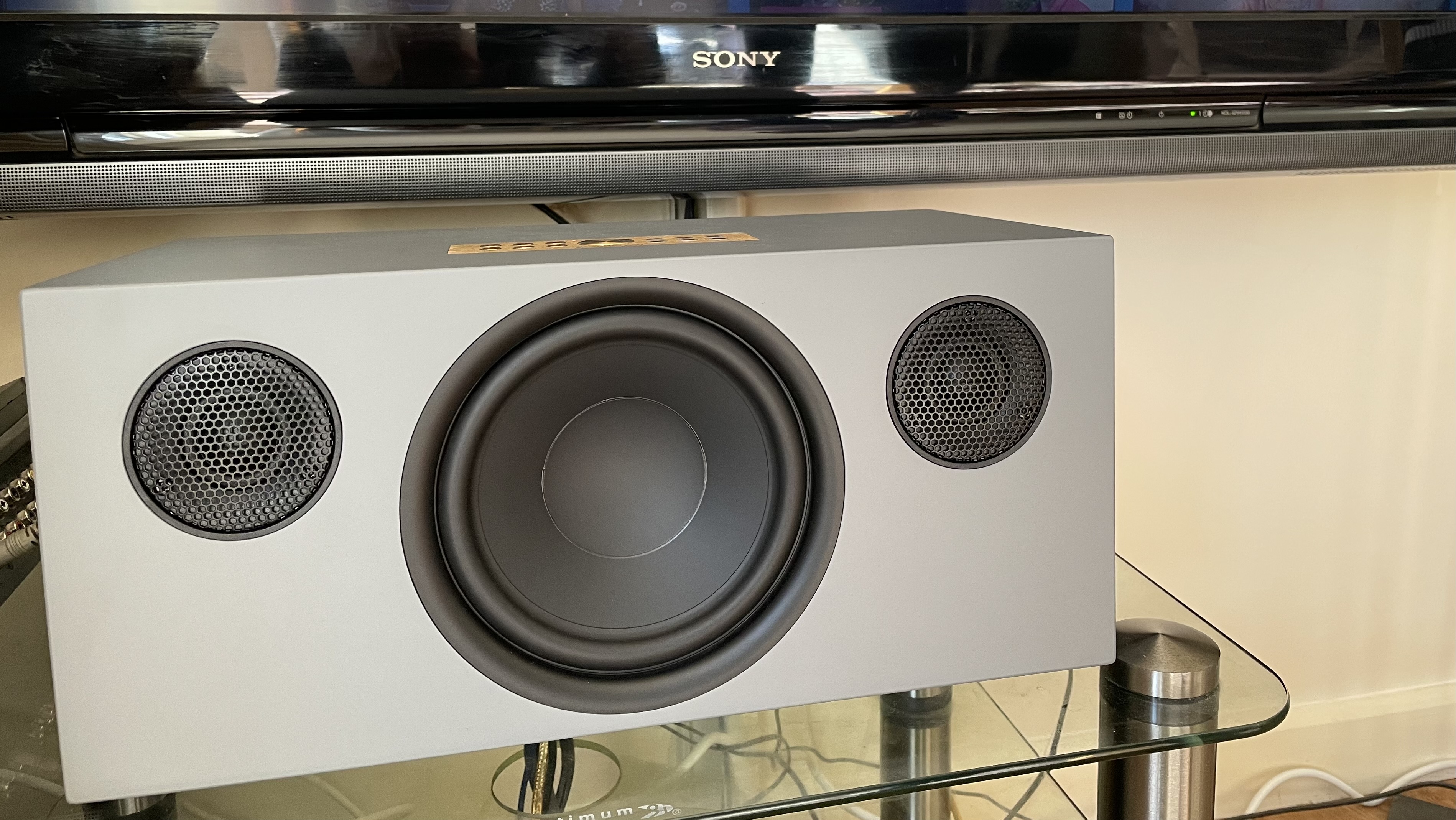
Audio Pro C20 review: Usability and setup
- Simple, app-guided setup
- App can handle your music – or not
- No supplied remote
After powering the speaker on (in case it needs to be mentioned, the C20 needs to be plugged in to power at all times), you're quickly guided to the Audio Pro companion app, which will add the C20 to your Wi-FI network and generally do the rest. During my time with it, it neither crashed nor tripped up even momentarily.
On the app, the 'Browse' tab (which seeks to keep your music all in one place) will open Apple Music natively through 'open on Apple Music' if using an iOS device, but third-party streaming services (such as Tidal) will require you to login again if going this route. You can also select the C20's source here, whether that's Wi-Fi, Bluetooth, phono, line in (I hooked it up to the FiiO R9 before setting it up and it did a fantastic job), optical or TV.
The central 'Device' tab in the app is meant to organise your speakers rather than your music, so here you can name your speaker, (either the model, or its placement in your home, such as 'kitchen') and with the C20 there's a three-band EQ tab for bass, treble and subwoofer out.
The third and final 'Settings' tab basically lets you choose which services are displayed on 'Browse', as well as an FAQ section and details on the app version you're running.
Audio Pro hasn't supplied a dedicated remote control in the box (although if you're using the HDMI ARC to your TV, you can just use your TV's remote for volume) and honestly, I don't miss it, because the app does the heavy lifting – or of course, you can use the premium top plate.
Usability and setup score: 5/5
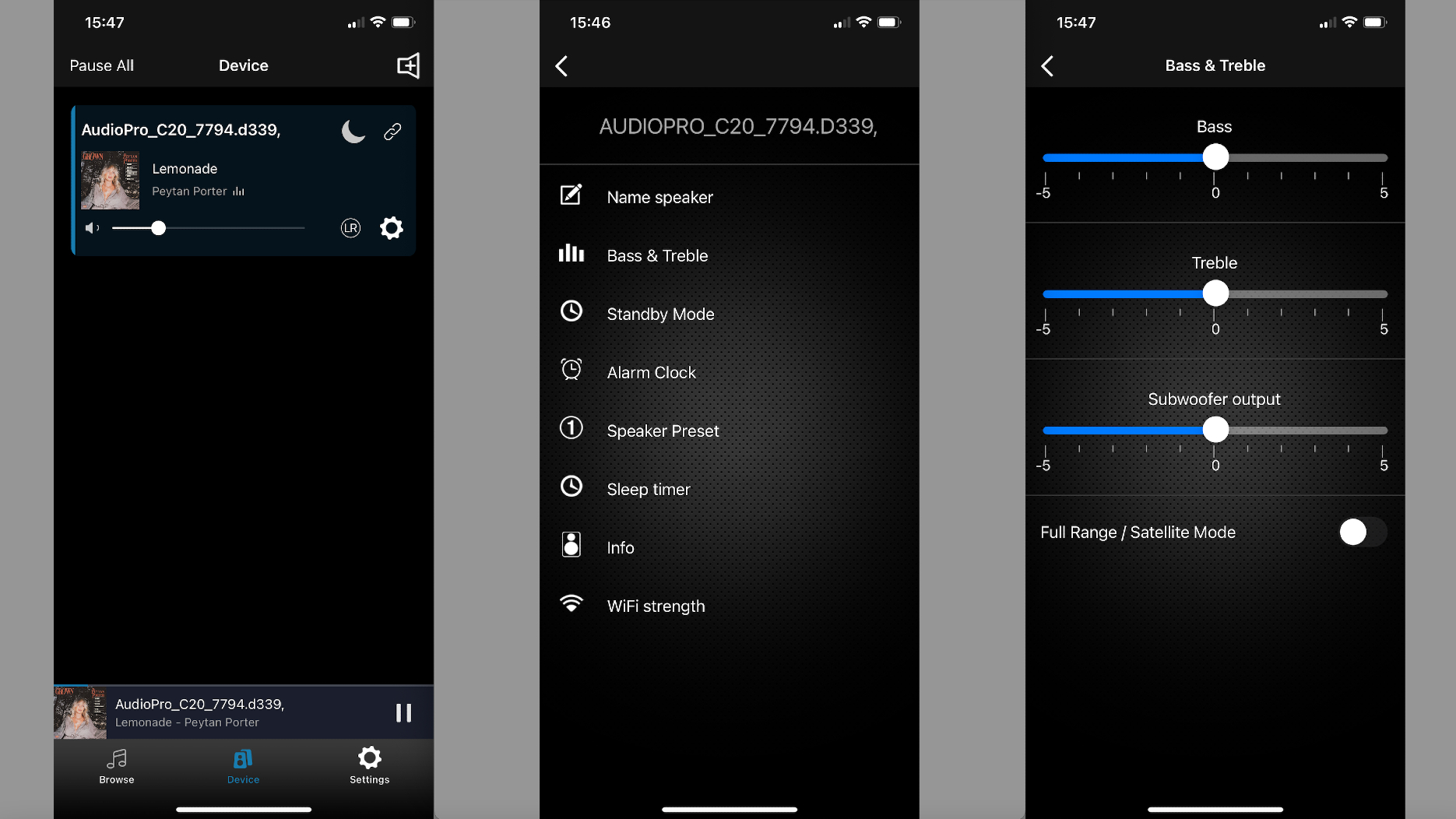
Audio Pro C20: Value
Obviously, if you don't have the expendable income to afford such a speaker, it doesn't matter how good it is – you won't be buying it.
That said, Sonus Faber will offer you something with a similar spec sheet that's double the price, while Naim has an older option that offers less in terms of connectivity, but sounds excellent, for similar money (see below for a comparison of these products).
My advice? You will not be disappointed with the sound-per-pound value here.
Value score: 4.5/5
Audio Pro C20 review: Should you buy it?
Buy it if...
You're looking to set up a multi-room audio system
This is an ideal gateway speaker for such an endeavour.
You access your music from several sources
This speaker will play your vinyl (and send it to other wireless speakers around your house), supply the soundtrack for your movie nights and stream your Bluetooth party tracks.
You delight in Scandi style
I mean, it's quite the looker, isn't it?
Don't buy it if...
You pretty much just use Bluetooth to stream music
You'll want a perfectly nice Bluetooth speaker – the Sonos Roam, JBL Flip 6 or Ultimate Ears Epicboom might be better fits for you.
You only use Spotify Free
Although wireless streaming means (much) better quality audio, it's still only as good as your source – which, for Spotify Free users, is far from hi-res…
Audio Pro C20: Also consider
| Audio Pro C20 | Naim Mu-so Qb (2019) | Sonus Faber Omnia | |
|---|---|---|---|
| Price | $550 / £450 (around AU$820) | $899 / £749 (around AU£1300) but can be found for less | $2,000 / £1,600 / AU$3,500 |
| Drivers | 2x 1-inch tweeters, 1x 6.5-inch woofer | 7-driver array | 7-driver array powered by a 490W amplifier |
| Connectivity (wireless) | 2.4GHz/5GHz Wi-Fi, Bluetooth 5.0, Tidal Connect, Spotify Connect, Google Cast, AirPlay 2, Audio Pro app for multi-room connectivity | Ethernet (10/100Mbps), Wi-Fi (802.11a/b/g/n/ac), BLE v4.2,Apple AirPlay 2, Chromecast Built-in, UPnPTM, Spotify Connect, TIDAL, Roon Ready, Bluetooth, Internet Radio | 2.4GHz/5GHz Wi-Fi, Bluetooth 5.0 (aptX HD), AirPlay, Chromecast, Spotify Connect |
| Weight | 6.2kg | 5.6kg | 7.6kg |
| Connectivity (wired) | HDMI ARC in, Phono, RCA line in, Optical Toslink in, Sub out | Optical S/PDIF, USB 2 (type A), 3.5mm jack | Switchable phono/line in (for turntable analog devices), HDMI Arc in, Ethernet port |
Sonus Faber Omnia
This comes with seven drivers under the bonnet (this time powered by a 490W amplifier) and unlike the Mu-so Qb (but like the Audio Pro C20) it's got HDMI ARC for hooking it up to your TV to handle soundbar duties. That said, while it's a similar size to the C20, it's a lot more expensive. See what we mean in our Sonus Faber Omnia review.
Naim Mu-so Qb (2019)
It's a good deal smaller than the C20, but it also boasts seven speakers under the hood and omnidirectional audio. No RCAs or HDMI ports when it comes to wired connectivity though, and the Bluetooth is v 4.2, so range takes something of a hit.
Read more in our full Naim Mu-so Qb (2019) review
Audio Pro C20 review: How I tested
- Tested across seven days
- Used as a TV soundbar, wireless speaker, wired to the FiiO R9, wired to a turntable and as a Wi-Fi and Bluetooth speaker
- Listened to a variety of music; watched three episodes of an action-packed TV show
When testing the Audio Pro C20, the only connection I didn’t use was the subwoofer out – because honestly, I really like Audio Pro's tuning within its speakers and never felt the need to try to augment the low end.
The analogue inputs accommodated both pre-amplified and non-amplified turntables, the digital optical was used for a CD player, the line in for FiiO R9 (as a source device), my TV was hooked up to it… and, of course, Bluetooth and my home Wi-Fi network were handy for using it with my iPhone.
And then it's the usual: listening to lots of familiar music from my reference playlist, (as well as three episodes of Shetland on TV, which I'm really into and highly recommend – yes, I know I'm late to that particular party) at a variety of volume levels, for the duration of my testing.
As a brief aside, I removed the grilles for the duration of my testing – it's what I always do whenever possible. Why? The fewer physical obstructions between you and your music, the better…
- First reviewed March 2024
- Read more about how we test

Becky became Audio Editor at TechRadar in 2024, but joined the team in 2022 as Senior Staff Writer, focusing on all things hi-fi. Before this, she spent three years at What Hi-Fi? testing and reviewing everything from wallet-friendly wireless earbuds to huge high-end sound systems. Prior to gaining her MA in Journalism in 2018, Becky freelanced as an arts critic alongside a 22-year career as a professional dancer and aerialist – any love of dance starts with a love of music. Becky has previously contributed to Stuff, FourFourTwo and The Stage. When not writing, she can still be found throwing shapes in a dance studio, these days with varying degrees of success.
